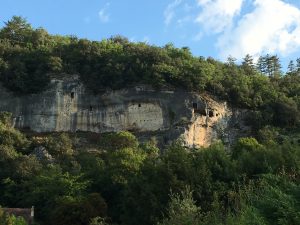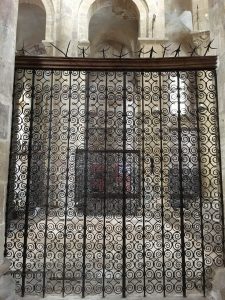I forget what wonderful sights you can see when you are moving at the speed of legs instead of wheels. I had an early morning run, and found the loveliest scene just around the bend from the town. Reminds me of the benefits of what I call “slow touring without windows” — on foot, by bicycle, or kayak. I think I need more of that sort of sightseeing. Case in point would be the beautiful scenery I passed along the way today. I was mostly on small roads, some without even a center line, and they curved and climbed and took me past some positively gorgeous views. Up on a ridge at one point I could see mountains in the far distance, and a beautiful valley with fields and an ancient village below. Another turn and I was climbling through a walled medieval village. I was unable to stop for photos so will have to keep those images in my mental memory photo album.
It was a 3 hour drive to the midi-Pyrenees area, just south and east of where I had been. I chose Conques because it’s on the Camino route that runs from Le Puy in France to St. Jean Pied to Port at the Spanish border, called the Podiensis trail. St Jean is where the Frances route through Spain begins. I hope to walk this one sometime in the future, and am quite jealous that Keith and Lynn (my British friends from Leek) will begin walking it in September. This wasn’t my year for a Camino, but I wanted to visit a village on the pilgrim trail as a reminder.
Set into a hillside just above the Lot River and overlooking the scenic Lot Valley, Conques has been a village since Roman times. The current Abbey Church was built in the 11th and 12thC’s in order to house the relics of Saint Foy, which had been seized from Agen in 866, and which caused the pilgrimage route to switch to Conques from Agen. It is a huge Romanesque structure, and the interior dome rises over 75 ft. The Tympanum over the front door has an entire book dedicated to explaining it, as it is a matrix of theological, liturgical, inellectual, feudal and moral elements. The grills inside are made from iron fetters taken from chains of prisoners to the intercession of Saint Faith and are still great examples of Roman ironwork. The rest of the interior is fairly bare, as the real treasures are displayed in a separate building. At the time saints were glorified by an abundance of precious materials, gold and silver and jewels set in the reliquaries of the remains of holy persons, which was one reason for the pilgrims to come. So there are all these medieval statues and crosses and plates in gold and silver and jeweled in the treasure room, which are brought out once a year for special worship. It’s the richest treasure of medieval goldsmith’s art in France, and had been largely forgotten about because it was taken from the church and hidden during the French Revolution, so it’s a pretty astounding collection.
The story of Saint Foy is moderately interesting. Foy (Faith) is said to have been a girl or young woman of Agen in Aquitaine. Her legend recounts how she was arrested during persecution of Christians by the Roman Empire and refused to make pagan sacrifices even under torture. Saint Faith was tortured to death with a red-hot brazier in about 290 and therefore martryed. There are stories which tell miracles from Saint Foy, which are described as tricks or jokes.
I stopped into a little gallery that was an exhibition of photographs from a pilgrim group that travelled from Switzerland through France and up to Mont St Michel. The photos brought back so many memories of walkers with huge backpacks and dusty shoes and a combination of weariness and pride over a beer at the end of the day. And I recognized that same look on the pilgrims I found in the square and on the narrow cobblestone streets. I guess it’s universal. Someday, another one for me.














The scenery is so peaceful and calming.